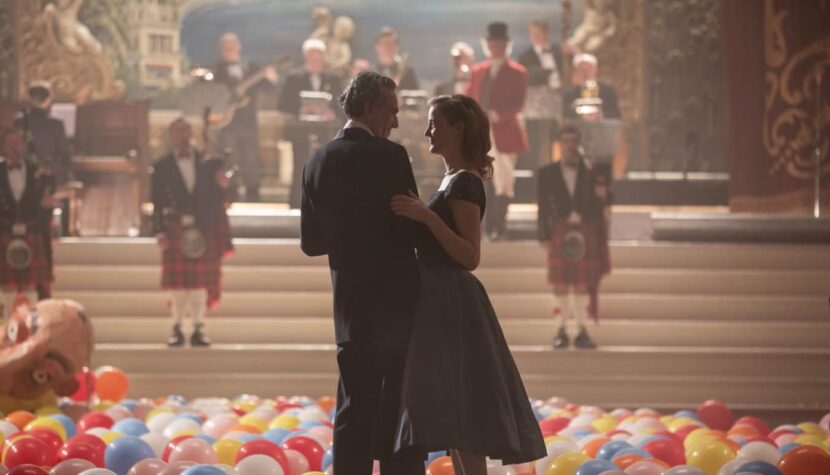PHANTOM THREAD. Perfectly tailored

Routine above all. In the early morning, a breakfast with sister (Lesley Manville) and simultaneously a close collaborator, consumed in absolute silence. During it, sketches of future dresses are created. Usually for the royal family, for the artistic elite, for the chosen ones. For those who can afford it. Right after, the seamstresses come to the studio: a perfectly coordinated team of masters of this craft. Each of them hears a warm “Good morning” as a greeting. In the afternoon, the protagonist has a planned walk. Outdoors, he can think, make sure that each project is heading in the right direction. Later, a light dinner. After that, there is time for sleep. Often interrupted in the middle of the night to measure something, to check some material, to continue designing. A rigid, predictable schedule of the day is absolutely crucial for a healthy existence. Meet Reynolds Woodcock (Daniel Day-Lewis).
This time, Paul Thomas Anderson, known for multi-threaded, panoramic films about groups, phenomena, and environments (Magnolia, Boogie Nights, Inherent Vice), takes on a story focused on individuals, and thus intimate and close. P. T. Anderson wins again.
In Phantom Thread, the director is interested not so much in fashion but in the artist’s image itself. How a strong emotional connection ties him to the created work. How he perceives the surroundings and the people around him. What relationships he enters into and what distance he maintains with them. What method of work, ambitions, weaknesses, and habits he has. In one of the first scenes of the film, a certain client receives the ordered dress. Woodcock carefully examines his design. He is not interested in the comments of the client, her satisfaction or dissatisfaction. The dress must please him above all. Only his satisfaction is the measure of success. On the other side is only the model, which gains significance only when dressed in the costume. The closing handshake between the client and Reynolds is a clear conclusion. The designer knows that he has created a masterpiece. Nothing else matters.

Anderson comprehensively builds a psychological portrait of Woodcock, completely capturing his character. The director is interested in mundane matters, such as the sound of peeling an egg. The sound distracts and does not allow the main character to work. In other cases, we deal with situations of much greater dramatic caliber: secret conversations with his sister Cyril (their ambiguous dialogues, reinforced by the play of glances, give this relationship an intriguing subtext) or marital crisis. Each of these plans adds a new shade to Woodcock’s image – a pedant, a enthusiast, and a perfectionist, taking himself and his work very seriously, giving it almost a metaphysical dimension. Anderson’s characters are defined not so much by pivotal moments but by details, nuances, and small gestures. To a large extent, these details testify to the structural greatness of Phantom Thread.
Reynolds Woodcock’s life changes drastically when young Alma (Vicky Krieps) moves into his house. A waitress working in the countryside, who attracts Reynolds’ attention with her figure. Initially, she is his muse, then a partner, and eventually a wife. It’s a typical melodramatic mismatch. However, for Paul Thomas Anderson, it is only a starting point. The director of There Will Be Blood does not follow the genre tropes. Phantom Thread is somewhat a film about love and desire, but Anderson gives priority to completely different emotions. It is obsession, fear, and anxiety that set the tone for Phantom Thread. The film is also not free from suffering, understood even purely physically.
Alma is definitely different from all the women surrounding Reynolds. She does not blindly submit to his demands, can talk back, and stand her ground. She likes to have her own opinion. The Reynolds-Alma relationship has a competitive character. A game in which neither side intends to give up. These are two equal opponents with authoritative tendencies. Anderson delves into the intricacies of a toxic relationship. By providing both sides with reasonable arguments, he makes the audience also have a problem deciding whom to cheer for. Both Alma and Reynolds occasionally cross the line of decency. They show their true faces, being truly cruel to each other. Sometimes hatred and helplessness are too strong. Accumulated negative emotions demand expression. As a result, we get one of the most intriguing and thought-provoking love stories of recent years.

Phantom Thread has its specific pace, which may not convince many. Despite this, Paul Thomas Anderson’s slow, devoid of elaborate staging narration can hypnotize at times. It is also subject to recurring sequences of taking measurements of successive clients. They serve as the refrain of Phantom Thread. They remind us of the established daily cycle of Reynolds Woodcock. A cycle over which he loses control.
“You can sew almost anything into the lining.” Such a sentence is uttered by Reynolds at one point. The artistic creed of the designer may also describe Phantom Thread itself. It is a film about two-faced and non-obvious characters. Difficult to decipher, hiding true intentions, or afraid to express them.
Phantom Thread is cinema that requires patience and focus. Get used to the slow rhythm of the film. The reward for the viewer is the discovery of what lies between the lines. Hearing everything that is not explicitly spoken.”

